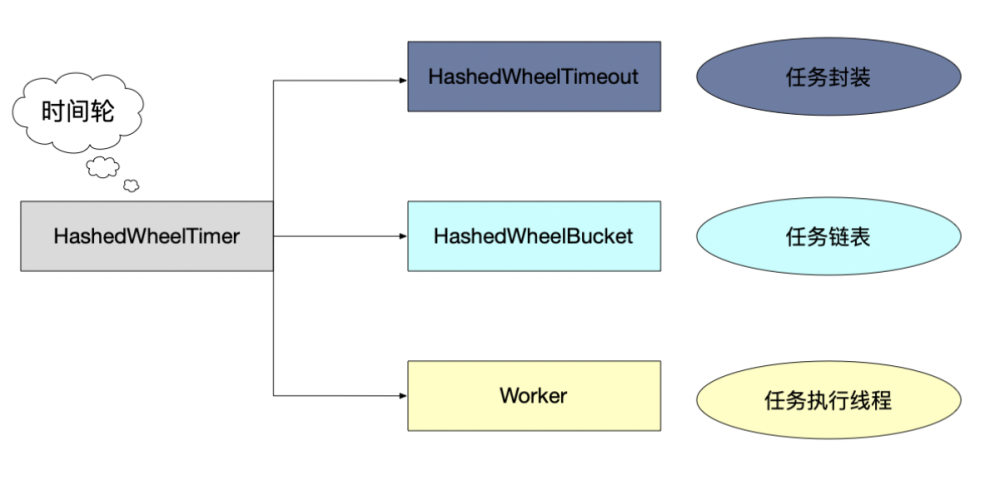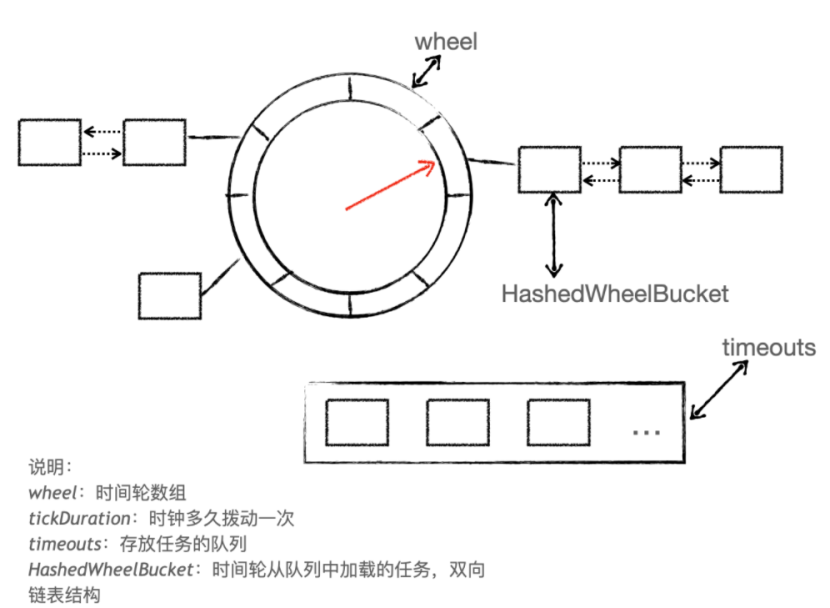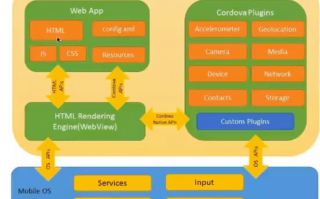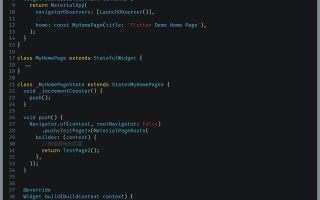SOFAJRaft的定时任务调度器是基于Netty来实现的,所以本文将会基于Netty时间轮算法,然后再结合SOFAJRaft源码进行分析。
@Author:Akai-yuan
@更新时间:2023/1/29
1.HashedWheelTimer概览
一个时间轮算法的组成成分图:
一个基于Netty实现的时间轮(HashedWheelTimer)有三个核心部分:HashedWheelTimeout(任务封装)、HashedWheelBucket(任务链表)、Worker(任务执行线程)

属性概览
HashedWheelTimer字段的具体作用全部以注释的形式标记在以下代码块中。
我们可以先看看HashedWheelTimer的属性,看不懂没有关系,可以先大致了解一下一个时间轮的属性有些什么。
//日志
private static final Logger LOG = LoggerFactoryLoggerFactory.getLogger(HashedWheelTimer.class);
//实例数量限制为256
private static final int INSTANCE_COUNT_LIMIT = 256;
//实例计数器
private static final AtomicInteger instanceCounter = new AtomicInteger();
//超过实例最大数量后是否警告标识,配合INSTANCE_COUNT_LIMIT字段使用
private static final AtomicBoolean warnedTooManyInstances = new AtomicBoolean();
//原子更新字段类,用于原子更新workerState属性
private static final AtomicIntegerFieldUpdater<HashedWheelTimer> workerStateUpdater =
AtomicIntegerFieldUpdater.newUpdater(HashedWheelTimer.class,"workerState");
//继承自Runnable,Worker是整个时间轮的执行流程管理者
private final Worker worker = new Worker();
//工作线程
private final Thread workerThread;
//工作状态码常量类【0 - init, 1 - started, 2 - shut down】
public static final int WORKER_STATE_INIT = 0;
public static final int WORKER_STATE_STARTED = 1;
public static final int WORKER_STATE_SHUTDOWN = 2;
//工作状态码
@SuppressWarnings({ "unused", "FieldMayBeFinal" })
private volatile int workerState;
// tick的时长,也就是指针多久转一格
private final long tickDuration;
//时间轮数组,每个位置是一个HashedWheelBucket
private final HashedWheelBucket[] wheel;
//寻址标识符用于快速寻址
//公式:mask==wheel.length-1
//原理:当x=2^n(n为自然数)时 a%x=a&(x-1)
private final int mask;
//一个等待startTime初始化的计数器
private final CountDownLatch startTimeInitialized = new CountDownLatch(1);
//用来暂时存放待加入时间轮的任务的队列
private final Queue<HashedWheelTimeout> timeouts = new ConcurrentLinkedQueue<>();
//用来暂时存放已被取消的任务的队列
private final Queue<HashedWheelTimeout> cancelledTimeouts = new ConcurrentLinkedQueue<>();
//未执行任务的计数器
private final AtomicLong pendingTimeouts = new AtomicLong(0);
//未执行任务的最大数量
private final long maxPendingTimeouts;
//开始时间
private volatile long startTime;
构造器概览
这个构造器里面主要做一些初始化的工作。
- 初始化一个数组长度为2048的Wheel时间轮。由于传入的数组长度可能为Big Number,所以我去SOFAJRaft上提了一个issue,建议采用JAVA8-HashMap的相关实现来完善该算法,可见于:ISSUE-时间轮算法存在多循环低效率问题
- 初始化mask,用来快速计算槽位的下标。
- 初始化tickDuration并转化成纳秒
- 校验整个时间轮走完的时间不能过长
- 将worker包装成thread
- 限制HashedWheelTimer实例数量
public HashedWheelTimer(ThreadFactory threadFactory, long tickDuration, TimeUnit unit, int ticksPerWheel,
long maxPendingTimeouts) {
//判空
if (threadFactory == null) {
throw new NullPointerException("threadFactory");
}
if (unit == null) {
throw new NullPointerException("unit");
}
if (tickDuration <= 0) {
throw new IllegalArgumentException("tickDuration must be greater than 0: " + tickDuration);
}
if (ticksPerWheel <= 0) {
throw new IllegalArgumentException("ticksPerWheel must be greater than 0: " + ticksPerWheel);
}
//将ticksPerWheel规格化为2的幂,并初始化轮子
wheel = createWheel(ticksPerWheel);
//寻址标识符
mask = wheel.length - 1;
//将tickDuration(时间单位为unit)转换为纳秒
this.tickDuration = unit.toNanos(tickDuration);
//防止溢出,指针转动的时间间隔不能超过:Long.MAX_VALUE/wheel.length
if (this.tickDuration >= Long.MAX_VALUE / wheel.length) {
throw new IllegalArgumentException(String.format(
"tickDuration: %d (expected: 0 < tickDuration in nanos < %d",
tickDuration, Long.MAX_VALUE/ wheel.length));
}
//将worker包装成thread
workerThread = threadFactory.newThread(worker);
//默认-1
this.maxPendingTimeouts = maxPendingTimeouts;
//如果HashedWheelTimer实例太多,会打印error日志
if (instanceCounter.incrementAndGet() > INSTANCE_COUNT_LIMIT
&& warnedTooManyInstances.compareAndSet(false, true)) {
reportTooManyInstances();
}
}
实现原理图:

HashedWheelTimer是整个时间轮算法的核心类,通过指定的Hash规则将不同TimeOut定时任务划分到HashedWheelBucket进行管理,而HashedWheelBucket利用双向链表结构维护了某一时刻需要执行的定时任务列表。
接上文SOFAJRaft源码阅读-模块启动过程,我们知道,在NodeImpl#init方法中,构造了多个RepeatedTimer实例:voteTimer、electionTimer、stepDownTimer、snapshotTimer。并且重写了RepeatedTimer#onTrigger和RepeatedTimer#adjustTimeout两个方法。紧接着,NodeImpl中的多个方法(如:init、electSelf、becomeLeader)会对这些RepeatedTimer实例调用RepeatedTimer#start方法启动。
2.启动计时器
- 加ReentrantLock锁,保证只能一个线程调用这个方法
- 启动状态参数校验
- 调用RepeatedTimer#schedule方法
- 释放锁
public void start() {
this.lock.lock();
try {
if (this.destroyed) {
return;
}
if (!this.stopped) {
return;
}
this.stopped = false;
if (this.running) {
return;
}
this.running = true;
schedule();
} finally {
this.lock.unlock();
}
}
3.任务调度
RepeatedTimer#start中会调用RepeatedTimer#schedule:
- 如果RepeatedTimer中维护的HashedWheelTimeout(任务)不为空,则取消(HashedWheelTimer#cancel)该任务。
- 声明一个TimerTask,并通过HashedWheelTimer#newTimeout()构造一个HashedWheelTimeout
private void schedule() {
if (this.timeout != null) {
this.timeout.cancel();
}
final TimerTask timerTask = timeout -> {
try {
//执行onTrigger,并设置状态参数
RepeatedTimer.this.run();
} catch (final Throwable t) {
LOG.error("Run timer task failed, taskName={}.", RepeatedTimer.this.name, t);
}
};
this.timeout = this.timer.newTimeout(timerTask, adjustTimeout(this.timeoutMs), TimeUnit.MILLISECONDS);
}
HashedWheelTimer#cancel:
取消一个任务,并将其放入另一个cancelledTimeouts队列
public boolean cancel() {
//只更新将在下一刻从HashedWheelBucket中删除的状态
if (!compareAndSetState(ST_INIT, ST_CANCELLED)) {
return false;
}
//如果一个任务应该被取消,我们将其放入另一个cancelledTimeouts队列,该队列将在每次tick时处理。
//因此,这意味着我们将有一个GC延迟,最大为1个tick的持续时间,这已经足够好了。
//这样,我们可以再次使用MpscLinkedQueue,从而尽可能减少锁定/开销。
timer.cancelledTimeouts.add(this);
return true;
}
4.往时间轮内添加任务
重点理解HashedWheelTimer#newTimeout:
- 判空
- 校验pendingTimeoutsCount参数的合理性,如果maxPendingTimeouts(最大的等待加入的任务的数量)为0或负数,则表示不需要对pendingTimeoutsCount进行数量限制,否则会进行比较,超过限制则会抛出异常。
- 调用HashedWheelTimer#start()启动时间轮。
- 计算当前添加任务的执行时间。传入的delay参数由RepeatedTimer#adjustTimeout(this.timeoutMs)获取
- 防溢出操作
- 最后将任务加入队列,此时还未加入到时间轮中,需要等待时钟拨动(也就是当调用链路HashedWheelTimer#start->workerThread#start->Worker#run->waitForNextTick返回了参数时)才会触发往时间轮内添加任务
public Timeout newTimeout(TimerTask task, long delay, TimeUnit unit) {
if (task == null) {
throw new NullPointerException("task");
}
if (unit == null) {
throw new NullPointerException("unit");
}
//等待的任务数 +1
long pendingTimeoutsCount = pendingTimeouts.incrementAndGet();
// 如果时间轮内等待的任务数大于最大值,任务会被抛弃
if (maxPendingTimeouts > 0 && pendingTimeoutsCount > maxPendingTimeouts) {
pendingTimeouts.decrementAndGet();
throw new RejectedExecutionException("Number of pending timeouts (" + pendingTimeoutsCount
+ ") is greater than or equal to maximum allowed pending "
+ "timeouts (" + maxPendingTimeouts + ")");
}
// 开启时间轮内的线程
start();
// 计算当前添加任务的执行时间
long deadline = System.nanoTime() + unit.toNanos(delay) - startTime;
// 防止溢出
if (delay > 0 && deadline < 0) {
deadline = Long.MAX_VALUE;
}
// 将任务加入队列(注意,此时还未加入到时间轮中)
HashedWheelTimeout timeout = new HashedWheelTimeout(this, task, deadline);
timeouts.add(timeout);
return timeout;
}
5.开启时间轮内的线程
我们知道,新添加的任务会先保存在timeouts队列中,当时间轮的时钟拨动时才会判断是否将队列中的任务加载进时间轮。那么工作线程开启后,start() 方法会被阻塞,等工作线程(workerThread.start())的 startTime 属性初始化完成后才被唤醒。
因为上面的 newTimeout 方法在线程开启后【start()】,需要计算当前添加进来任务的执行时间【long deadline = System.nanoTime() + unit.toNanos(delay) - startTime;】,而这个执行时间是根据 startTime 计算的。
HashedWheelTimer#start:
- 判断当前时间轮的状态,如果是初始化,则启动worker线程,启动整个时间轮;如果已经启动则略过;如果是已经停止,则报错。
- 如果初始化未完成,则需要等待worker线程完成startTime的初始化
public void start() {
// Lock Free设计。可能有多个线程调用启动方法,这里使用AtomicIntegerFieldUpdater原子的更新时间轮的状态,
// 它是JUC里面的类,利用反射进行原子操作。有比AtomicInteger更好的性能和更低得内存占用
switch (workerStateUpdater.get(this)) {
case WORKER_STATE_INIT:
if (workerStateUpdater.compareAndSet(this, WORKER_STATE_INIT, WORKER_STATE_STARTED)) {
workerThread.start();
}
break;
case WORKER_STATE_STARTED:
break;
case WORKER_STATE_SHUTDOWN:
throw new IllegalStateException("cannot be started once stopped");
default:
throw new Error("Invalid WorkerState");
}
// startTimeInitialized 是一个 CountDownLatch,目的是为了保证工作线程的 startTime 属性初始化
// startTime的初始化和startTimeInitialized.countDown()方法会在Worker#run
// [也就是workerThread.start()中]完成
while (startTime == 0) {
try {
startTimeInitialized.await();
} catch (InterruptedException ignore) {
// Ignore - it will be ready very soon.
}
}
}
6.时间轮调度
**
时间轮每拨动一次就会触发tick++,然后tick与mask(时间轮数组长度 - 1)进行 & 运算,可以快速定位时间轮数组内的槽【mask寻址标识符用于快速寻址,其原理:当x=2^n(n为自然数)时 a%x=a&(x-1)】。因为 tick 值一直在增加,所以时间轮数组看起来就像一个不断循环的圆。
- 先初始化 startTime 值,因为后面任务执行的时间是根据 startTime 计算的
- 时钟拨动,如果时间未到,则 sleep 一会儿
- 处理过期的任务
- 将任务加载进时间轮
- 执行当前时钟对应时间轮内的任务
- 时间轮关闭,将所有未执行的任务封装到 unprocessedTimeouts 集合中,在 stop 方法中返回出去
- 处理过期的任务
public void run() {
// 初始化 startTime
startTime = System.nanoTime();
if (startTime == 0) {
startTime = 1;
}
// 用来唤醒被阻塞的 HashedWheelTimer#start() 方法,保证 startTime 初始化
startTimeInitialized.countDown();
do {
// 时钟拨动,有返回值(必须是正数)的时候说明可以拨动时钟了
final long deadline = waitForNextTick();
if (deadline > 0) {
int idx = (int) (tick & mask);
// 处理过期的任务
processCancelledTasks();
HashedWheelBucket bucket = wheel[idx];
// 将任务加载进时间轮
transferTimeoutsToBuckets();
// 执行当前时间轮槽内的任务
bucket.expireTimeouts(deadline);
tick++;
}
} while (workerStateUpdater.get(HashedWheelTimer.this) == WORKER_STATE_STARTED);
// 时间轮关闭,将还未执行的任务以列表的形式保存到 unprocessedTimeouts 集合中,在 stop 方法中返回出去
// 还未执行的任务可能会在两个地方,一:时间轮数组内,二:队列中
for (HashedWheelBucket bucket : wheel) {
bucket.clearTimeouts(unprocessedTimeouts);
}
for (;;) {
HashedWheelTimeout timeout = timeouts.poll();
if (timeout == null) {
break;
}
if (!timeout.isCancelled()) {
unprocessedTimeouts.add(timeout);
}
}
processCancelledTasks();
}
7.时间拨动
Worker#waitForNextTick:
- 当时钟拨动一次后,应该计算下一次时钟拨动的时间
- 获取当前时间的相对时间
- 计算距离时钟下次拨动的时间,也就是sleepTimeMs。这里之所以加 999999 后再除 10000000, 是为了保证足够的 sleep 时间。例如:当 deadline - currentTime = 2000002 的时候,如果不加 999999,则只睡了 2ms。而 2ms 其实是未到达 deadline 时间点的,所以为了使上述情况能 sleep 足够的时间,加上 999999 后,会多睡 1ms。
- 如果还没到就 sleep 一会儿,等到拨动时间再醒来。
- 进入下一次循环,直到sleepTimeMs<=0 说明可以拨动时钟了
private long waitForNextTick() {
// 计算时钟下次拨动的相对时间
long deadline = tickDuration * (tick + 1);
for (;;) {
// 获取当前时间的相对时间
final long currentTime = System.nanoTime() - startTime;
// 计算距离时钟下次拨动的时间
long sleepTimeMs = (deadline - currentTime + 999999) / 1000000;
// <=0 说明可以拨动时钟了
if (sleepTimeMs <= 0) {
if (currentTime == Long.MIN_VALUE) {
return -Long.MAX_VALUE;
} else {
return currentTime;
}
}
// sleep 到下次时钟拨动
try {
Thread.sleep(sleepTimeMs);
} catch (InterruptedException ignored) {
if (workerStateUpdater.get(HashedWheelTimer.this) == WORKER_STATE_SHUTDOWN) {
return Long.MIN_VALUE;
}
}
}
}
8.移除取消的任务
Worker#processCancelledTasks:
- 遍历cancelledTimeouts中所有实例并从其对应HashedWheelBucket中移除。
- 在调用HashedWheelTimer的stop方法的时候会将要取消的HashedWheelTimeout实例放入到cancelledTimeouts队列中,所以这里只需要循环把队列中的数据取出来,然后调用HashedWheelTimeout的remove方法将自己在bucket移除就好了。
private void processCancelledTasks() {
//遍历cancelledTimeouts中所有实例并从其对应HashedWheelBucket中移除
for (;;) {
HashedWheelTimeout timeout = cancelledTimeouts.poll();
if (timeout == null) {
// all processed
break;
}
try {
timeout.remove();
} catch (Throwable t) {
if (LOG.isWarnEnabled()) {
LOG.warn("An exception was thrown while process a cancellation task", t);
}
}
}
}
9.将任务从队列加载进时间轮
Worker#transferTimeoutsToBuckets:
在上面也提到过,任务刚加进来不会立即到时间轮中去,而是暂时保存到一个队列中,当时间轮时钟拨动时,会将任务从队列中加载进时间轮内。
- 每次调用这个方法会处理10w个任务,以免阻塞worker线程
- 从timeouts中取出任务
- 在校验之后会用timeout的deadline除以每次tick运行的时间tickDuration得出需要经过多少次时钟拨动才会运行这个timeout的任务
- 计算时间轮拨动的圈数。由于timeout的deadline实际上还包含了worker线程启动到timeout加入队列这段时间,所以在算remainingRounds的时候需要减去当前的tick次数。
- 将任务加载进时间轮对应的槽内,可能有多个任务经过 hash 计算后定位到同一个槽,这些任务会以双向链表的结构保存,有点类似 HashMap 处理碰撞的情况。
private void transferTimeoutsToBuckets() {
// 一次最多只处理队列中的 100000 个任务
for (int i = 0; i < 100000; i++) {
HashedWheelTimeout timeout = timeouts.poll();
if (timeout == null) {
// all processed
break;
}
// 过滤已经取消的任务
if (timeout.state() == HashedWheelTimeout.ST_CANCELLED) {
// Was cancelled in the meantime.
continue;
}
// 计算当前任务到执行还需要经过几次时钟拨动
// 假设时间轮数组大小是 10,calculated 为 12,需要时间轮转动一圈加两次时钟拨动后后才能执行这个任务,因此还需要计算一下圈数
long calculated = timeout.deadline / tickDuration;
// 计算当前任务到执行还需要经过几圈时钟拨动
timeout.remainingRounds = (calculated - tick) / wheel.length;
// 有的任务可能在队列里很长时间,时间过期了也没有被调度,将这种情况的任务放在当前轮次内执行
final long ticks = Math.max(calculated, tick); // Ensure we don't schedule for past.
// 计算任务在时间轮数组中的槽
int stopIndex = (int) (ticks & mask);
HashedWheelBucket bucket = wheel[stopIndex];
// 将任务放到时间轮的数组中,多个任务可能定位时间轮的同一个槽,这些任务通过以链表的形式链接
bucket.addTimeout(timeout);
}
}
10.执行任务
HashedWheelBucket#expireTimeouts:
时间轮槽内的任务以链表形式存储,这些任务执行的时间可能会不一样,有的在当前时钟执行,有的在下一圈或者之后几圈对应的时钟才会执行。当任务在当前时钟执行时,需要将这个任务从链表中删除,重新维护链表关系。
public void expireTimeouts(long deadline) {
HashedWheelTimeout timeout = head;
// process all timeouts
while (timeout != null) {
HashedWheelTimeout next = timeout.next;
// 任务执行的圈数 > 0,表示任务还需要经过 remainingRounds 圈时钟循环才能执行
if (timeout.remainingRounds <= 0) {
// 从链表中移除当前任务,并返回链表中下一个任务
next = remove(timeout);
if (timeout.deadline <= deadline) {
// 执行任务
timeout.expire();
} else {
// The timeout was placed into a wrong slot. This should never happen.
throw new IllegalStateException(String.format("timeout.deadline (%d) > deadline (%d)",
timeout.deadline, deadline));
}
} else if (timeout.isCancelled()) {
// 过滤取消的任务
next = remove(timeout);
} else {
// 圈数 -1
timeout.remainingRounds--;
}
timeout = next;
}
}
HashedWheelTimeout#expire:
- CAS切换任务状态
- task.run(this)执行任务
public void expire() {
// CAS任务状态变换
if (!compareAndSetState(ST_INIT, ST_EXPIRED)) {
return;
}
try {
task.run(this);
} catch (Throwable t) {
if (LOG.isWarnEnabled()) {
LOG.warn("An exception was thrown by " + TimerTask.class.getSimpleName() + '.', t);
}
}
}
11.终止时间轮
**HashedWheelTimer#stop(): **
触发终止时间轮的链路为:NodeImpl#destroyAllTimers()->RepeatedTimer#destroy()->timer.stop()
- 当终止时间轮时,将时间轮的状态修改为 WORKER_STATE_SHUTDOWN。时间轮状态有两种情况:(1)WORKER_STATE_INIT:当初始化时间轮对象时并不会立即开启时间轮工作线程,而是第一次添加任务时才开启,此状态表示时间轮没有处理过任务(2)WORKER_STATE_STARTED:时间轮在工作,这里也有两种情况,存在并发与不存在并发,如果多个线程都尝试终止时间轮,肯定只能有一个成功。
- 时间轮停止运行后会将未执行的任务返回出去,至于怎么处理这些任务,由业务方自己定义,这个流程和线程池的 shutdownNow 方法是类似的。
- 如果时间轮在运行,如果时间轮处于非运行状态,会把时间轮数组与队列中未执行且未取消的任务保存到 unprocessedTimeouts 集合中。而终止时间轮成功的线程只需要等待一会儿,这个等待通过 workerThread.join(100)实现。
public Set<Timeout> stop() {
// 终止时间轮的线程不能是时间轮的工作线程
if (Thread.currentThread() == workerThread) {
throw new IllegalStateException(HashedWheelTimer.class.getSimpleName() + ".stop() cannot be called from "
+ TimerTask.class.getSimpleName());
}
// 将时间轮的状态修改为 WORKER_STATE_SHUTDOWN,这里有两种情况
// 一:时间轮是 WORKER_STATE_INIT 状态,表明时间轮从创建到终止一直没有任务进来
// 二:时间轮是 WORKER_STATE_STARTED 状态,多个线程尝试终止时间轮,只有一个操作成功
if (!workerStateUpdater.compareAndSet(this, WORKER_STATE_STARTED, WORKER_STATE_SHUTDOWN)) {
// 代码走到这里,时间轮只能是两种状态中的一个,WORKER_STATE_INIT 和 WORKER_STATE_SHUTDOWN
// 为 WORKER_STATE_INIT 表示时间轮没有任务,因此不用返回未处理的任务,但是需要将时间轮实例 -1
// 为 WORKER_STATE_SHUTDOWN 表示是 CAS 操作失败,什么都不用做,因为 CAS 成功的线程会处理
if (workerStateUpdater.getAndSet(this, WORKER_STATE_SHUTDOWN) != WORKER_STATE_SHUTDOWN) {
// 时间轮实例对象 -1
instanceCounter.decrementAndGet();
}
// CAS 操作失败,或者时间轮没有处理过任务,返回空的任务列表
return Collections.emptySet();
}
try {
boolean interrupted = false;
while (workerThread.isAlive()) {
// 中断时间轮工作线程
workerThread.interrupt();
try {
// 终止时间轮的线程等待时间轮工作线程 100ms,这个过程主要是为了时间轮工作线程处理未执行的任务
workerThread.join(100);
} catch (InterruptedException ignored) {
interrupted = true;
}
}
if (interrupted) {
Thread.currentThread().interrupt();
}
} finally {
instanceCounter.decrementAndGet();
}
// 返回未处理的任务
return worker.unprocessedTimeouts();
}
写在后面
SOFAJRaft采用的是Netty的时间轮算法来实现任务调度器,但是Netty的时间轮算法存在一定缺陷,比如:它是通过单线程实现的,如果在执行任务的过程中出现阻塞,会影响后面任务执行。Netty 中的时间轮并不适合创建延迟时间跨度很大的任务,比如往时间轮内丢成百上千个任务并设置 10 天后执行,这样可能会导致链表过长 round 值很大,而且这些任务在执行之前会一直占用内存。
到这里SOFAJRaft的定时任务调度器就差不多完整的走了一遍,第一遍看确实很容易懵逼,但是再读几遍还是会感觉很有成就感的。作者总结完这篇文章,差不多刚过完年,希望后面能继续坚持下去。









还木有评论哦,快来抢沙发吧~